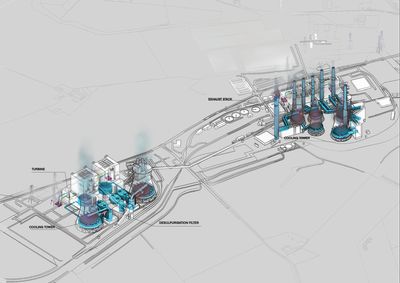AtlasBrown CoalYee Shuang Sim, Dara Rüfenacht, and Shriya Chaudhry
At the beginning of our modern age stands the industrial revolution. This was a time of change: A change from organic energy to mineral energy, a mechanisation of production processes and an intense commodifying of the land. This development was fuelled by coal as the new primary energy source for the people and the industry. The legal and historical context made brown coal a relatively cheap and locally available energy source in Germany. However this idea of cheap energy does not take into account the eternal costs brown coal mining and burning bring with them.
The mining pits move through the landscape and swallow everything on their way. They destroy the soil, the land and the social networks inherent in the region. The law forces the mining companies to recultivate the land after the excavation process. They have the ultimate control over the land and with this the ability to create a new landscape. They attempt to erase all traces of the mining, and yet the land remains engraved with the history of this vast industrial transformation.

Source: Bernhard Lang, 2014.
Brown Coal Is A Low Grade Coal Product
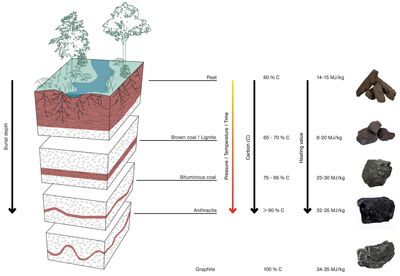
Source: Coal, 2019.
Coalification is the process of carbonisation of plant matter, that creates different types of coal. They are defined by their concentration of carbon and their corresponding heating values. Over time the plant material is covered by more and more sediments. This raises the levels of pressure and heat which drives the process of carbonisation. Through this process different types of coal can be found at different depths in the ground.
Brown Coal Fueled Industrialisation
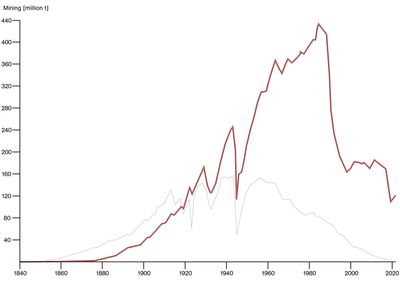
HISTORICAL DEVELOPMENT OF COAL MINING IN GERMANY
Source: Bundesanstalt für Geowissenschaften und Rohstoffe.
- Brown coal
- Hard coal
In Germany brown coal has a long history as an important energy source. It was the foundation of a rapid industrialisation and the driving force behind economic growth and energy autarky.
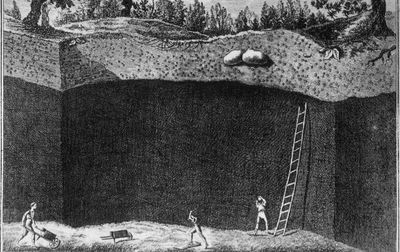
Source: Unternehmen Braunkohle, Arno Kleinbeckel, 1986.
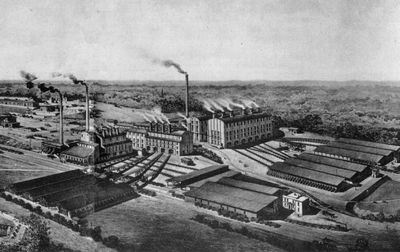
Source: Unternehmen Braunkohle: Arno Kleinbeckel, 1986.
In pre-industrial times, brown coal was mined by hand as a byproduct of clay mining sites. It was pressed into briquets and used as a heating material.
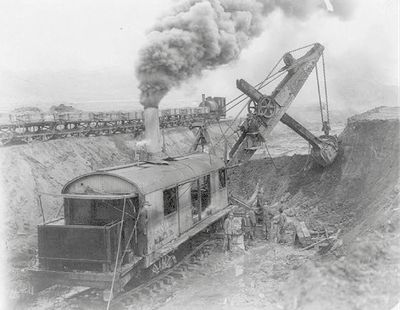
Source: P.J. Thompson, Library of Congress, 1906.
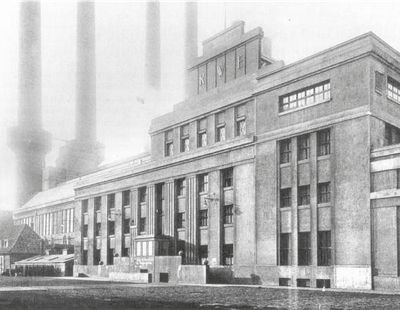
Source: Das Rheinische Braunkohlenrevier als Denkmalslandschaft: Landschaftsverband Rheinland, 2002.
With the industrialisation in the 19th century came a growing mechanisation and more machinery in the mining of brown coal. The coal was still mainly used to produce thermal energy. Only the lack of available hard coal, as a result of the first World War and the Treaty of Versailles, lead to an investment into brown coal power generation.
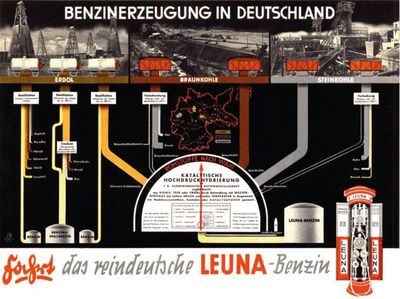
Source: Kohle zu Benzin, 1931.

Source: RWE, 1967.
In Nazi Germany brown coal was used to create petrol by liquifying it through hydrogenation. This supported the political goal of a self-sufficient national energy production.
With the oil crisis of the 1970s brown coal boomed as an energy source. With this came a concentration of economical power in the mining districts. Brown coal mining in Germany reached it’s peak in the 1980s.
Geological Conditions Of Open Pit Mining

BROWN COAL RESERVES IN EUROPE
Source: Euracoal.
- Permian, Carboniferous and Devonian geological surfaces
- Brown coal reserves
- Active brown coal mines
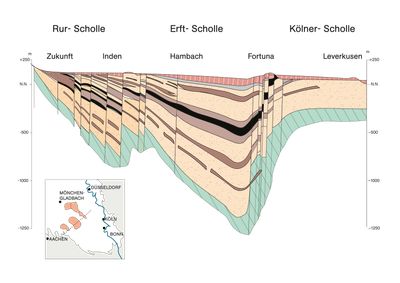
SOIL PROFILE OF THE LOWER RHINE BAY
Source: Der Braunkohlentagebau, 2009.
- Gravel and sand (Quarter)
- Sand and gravel (Tertiary)
- Sand and clay (Tertiary)
- Clay (Tertiary)
- Brown coal (Carboniferous)
- Clay and sand (Devonian)
Brown coal can mainly be found in the Permian, Carboniferous and Devonian geological surfaces. It lays in the ground as specific layers at around 300 to 500 meters depth. Due to the tectonic activities these layers move over time and are split apart into the coal seams of today. Those two aspects are the reason why brown coal is mined from the surface in an open pit.
Low Efficiency Metabolism
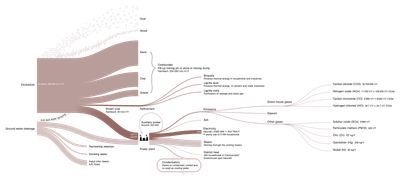
MATERIAL FLOW AND PROCESSES OF BROWN COAL POWER GENERATION
Source: RWE Power AG. BUND NRW. Thru.de. IPCC.
The material flows of brown coal power generation show a very one sided relation between waste material output, as overburden, and electric output. Even with the most technologically advanced methods available today brown coal only reaches an efficiency of 43 %. A large amount of energy is lost as heat, which evaporates as steam into the atmosphere. Additionally to this brown coal also produces extensive amounts of emissions with long term negative effects on people’s health and the ecology of the planet.
Oversized Technologies

Source: Wie funktioniert Tagebau?, RWE Power AG, 2013.
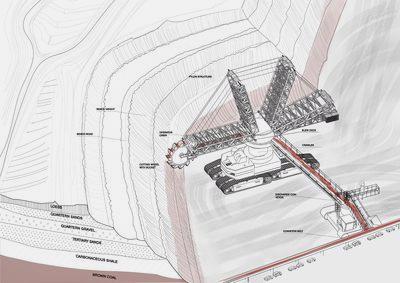
The bucket-wheel excavator (BWE) has been used in mining for the past century. It is used in conjunction with many other pieces of mining machinery (conveyor belts, spreaders and crushing stations) to excavate and move massive amounts of overburden (waste material) and brown coal.
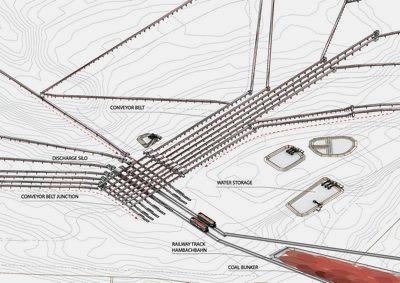
From the bucket-wheel excavator all the excavation material is dropped directly onto the 115km long conveyor belt system. The conveyor belt transports it at 27 km/h to the junction point, from where the different materials are distributed to their target locations.

Source: Braunkohlekraftwerk Animation, Bundesverband Braunkohle, 2016.
The process of power generation starts with the arrival of coal from the coal mines by railways. The coal is taken to the pulveriser to convert it into a fine powder. This coal dust is fed into the boiler. The thermal energy released from this fuel is used to boil the water up to 500 degrees Celsius, thus converting it into high-pressure steam which is transferred to the turbines.
The turbines turn at a really high frequency, converting the pressure energy of the steam into mechanical energy. This energy is used to make electricity through a generator. The voltage output of the generator is further stepped up, to be transferred to the nearest power grid through transmission cables.
To relax and cool down the steam, it is condensed. Cool water from a reservoir is pumped to the condenser and after the heat exchange, it is pumped back to the water body. The rest of the heat is released from the cooling tower as steam. The fumes from the furnace are filtered and desulphurised before being released into the atmosphere through the stacks.
Mining Landscapes in the Rheinische Revier

Source: Google Earth Pro.
Over time the mining pits are moving through the landscape of the Rheinische Revier, following the coal seams. They eat up everything that lays in their way: the farmland, the villages and the forests. When all the coal is extracted the area is recultivated by the mining company. Through the mining the entire region undergoes a cycle of extraction and recultivation.
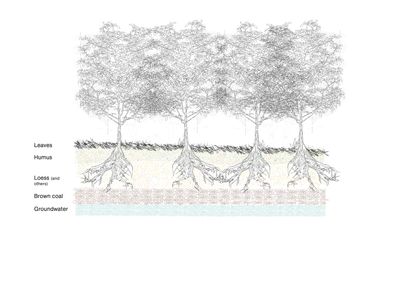


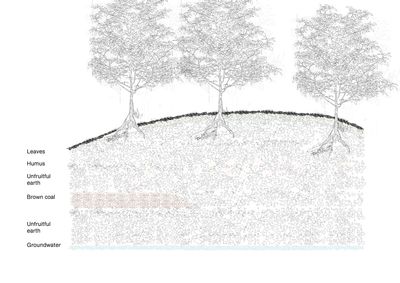
In detail, the cycle of extraction and recultivation of the forest takes four major steps: First the land before deforestation is a healthy forest with a decent amount of humus. Under it lay different types of soil, such as loess and clay. Deep down in the ground is the brown coal seam. All those layers are wet from the ground water, whose highest layers lay around the same depth and below the brown coal. To begin its operations the mining company has to cut down the trees and drain the ground water to a lower level. They excavate the upper layers of soil to reach the brown coal seam. This overburden is transported to the other side of the mine and used as infill material. When the mining company has extracted all the available brown coal they are legally obligated to recultivate the land. To achieve this they fill up the ground with the overburden soil materials. When the desired height is reached a top soil layer of humus is added to allow the growth of new plants. Trees and bushes are planted using seeds from the forest that stood there before to ensure the right plant diversity. Animals are transported there to create the necessary biodiversity.
Although RWE claim that this recultivation is a restoration of the soil, it loses at least part of its properties due to the digging and rearranging. The new forest would take a long time to reach the ecosystem qualities of the original one. This is especially problematic considering that, according to the IPCC, the landscape in this region (Nordrhein-Westfalen) will have to deal with more intense heatwaves in the future. Because of this the new forest is at a higher risk of burning down. Additionally the ground water level cannot simply be restored. This is a geological process that will take hundreds of years. Until then the soil is drier. All these factors mean that the recultivated soil cannot be seen the same as the original, it has new properties and therefore new challenges.
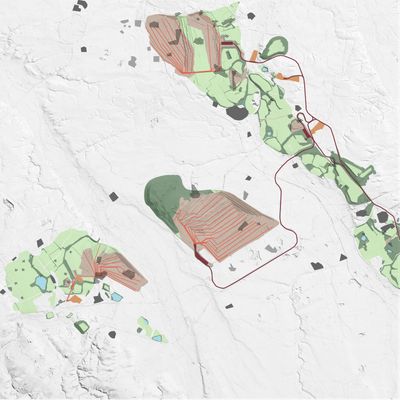
THE BROWN COAL MINING LANDSCAPE OF THE RHEINISCHE REVIER
Source: Thomas Römer, wikimedia commons, 2018.
- Mining areas
- Waterbodies
- Forestry recultivation
- Agricultural recultivation
- Conveyor belts
- Railway tracks
- Power plants
 Former villages
Former villages- Resettled Villages
- Villages origianlly planned to be mined away

